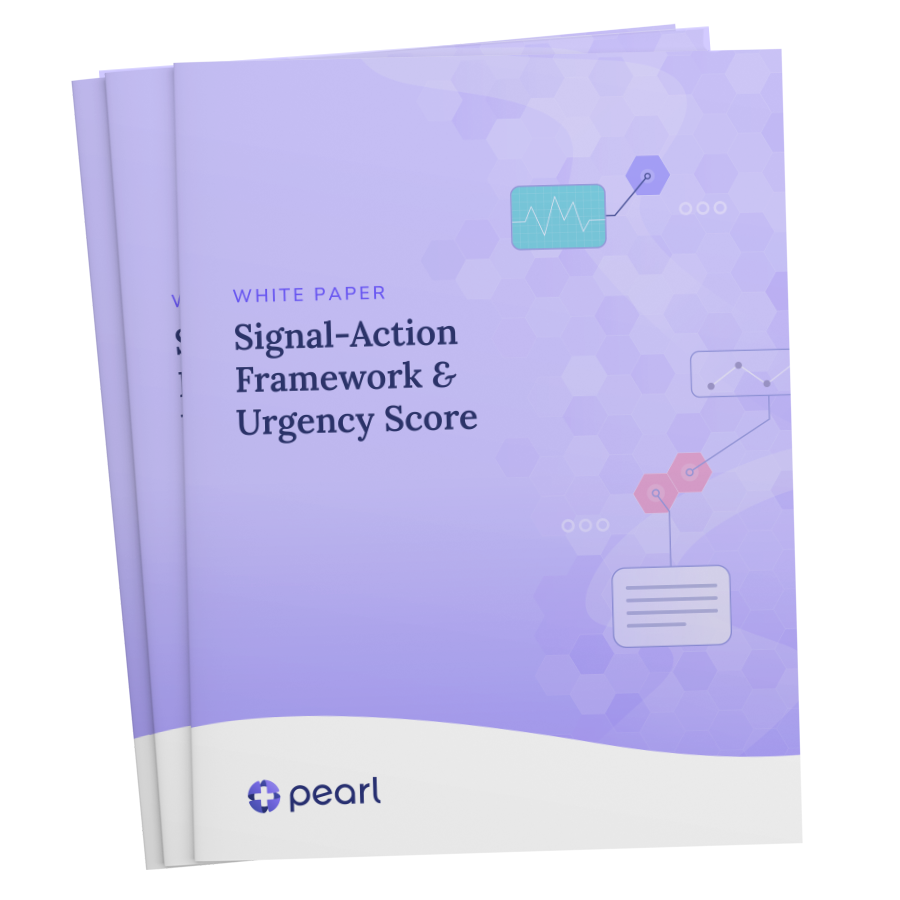When patients leave the hospital, their journey to recovery is far from over. In fact, it’s during this crucial transitional period that they’re most vulnerable to complications and setbacks that can lead to unplanned readmissions, higher mortality rates, and unnecessary health care costs. That’s where Transitional Care Management (TCM) comes in. TCM is intended to reduce complications and improve clinical outcomes after discharge through a combination of care coordination, patient communication, and medical decision making. When completed effectively, this support and guidance enhances patient satisfaction and outcomes, reduces healthcare costs, and improves care continuity while helping people successfully transition back to their everyday lives.
Despite its proven value — with internal analysis and external literature finding 90-day savings of $3,000-$4,000 per discharge — TCM remains underutilized.1,2 External literature shows that just 7% of eligible discharges received this cost-effective care in 2015,3 and an analysis of the Pearl population showed 15% of eligible discharges received it in 2022.4 Our partner practices demonstrated a wide range of adoption, with TCM rates ranging from just 1% all the way up to 55% of eligible discharges. This indicates that there is ample room for improvement.
In this blog post, we explore the benefits of TCM and the potential for increased adoption in healthcare practices.
The Power of Transitional Care Management
Multiple studies have quantified the value of TCM for both patients and the healthcare system over the years. For example, a 2018 study analyzing almost 19 million eligible Medicare discharges found that TCM was associated with significantly reduced costs and mortality,5 while another 2018 study found that TCM reduced Medicare spending by 31% in the 6-month period after discharge.6
More recently, Pearl Health implemented a regression model to predict 90-day utilization and spend post-inpatient discharge among our partner practices. The model controlled for TCM eligibility, patient demographics and practice membership, length of stay, Major Diagnosis Category (MDC), and pre-discharge utilization and spend. Our results showed that among the Pearl population in 2022, TCM resulted in total savings of about $3,000 over the 90-day period following a hospital discharge.7
* Overall savings account for smaller sources of savings and costs that are not captured in this table.
While it’s important to note that TCM did increase some costs, with home health services increasing by about $350 per discharge and specialty services increasing by almost $200 per discharge, the benefits of lower skilled nursing facility (SNF) and inpatient (IP) spend significantly outweighed these marginal increases. The $3,000 in overall TCM savings per discharge accounted for the minor cost increases elsewhere.
Moreover, our research highlighted that TCM is effective across all Major Diagnostic Categories, with some providing an especially-high opportunity for improved clinical outcomes and savings. Discharges with a principal diagnosis of Infectious and Parasitic Diseases (MDC 18, which includes sepsis) presented the highest opportunity for cost savings at $5,000 in total savings per discharge over the 90-day period following a hospital discharge.
Different Populations, Different Opportunities
Comparing our findings with existing academic literature, we see a consistent association between TCM, reduced spend, and improved outcomes across patient populations. However, digging deeper, we also see that the opportunity manifests itself differently across populations. For example, existing literature suggests that the impact of TCM comes primarily from reductions in 30-day readmission rates.8
In contrast, our study found that TCM savings were driven primarily by reductions in SNF spend due to shorter length of stays, as well as lower IP spend during the crucial 90-day post-discharge period. While IP savings also indicate a reduction in readmissions, their impact on TCM-related savings was secondary to that of SNF, and the savings account for a 90 day period post-discharge rather than 30. TCM improved outcomes and lowered costs in the external literature and across Pearl’s partner practices, but the opportunity varied by population.
While readmission rates are an important metric to consider, our findings challenge the prevailing notion and underscore the complexity of post-discharge care. Practices that want to cut through the noise to improve care and reduce costs must look at their unique patient population, understand where the opportunities for clinical improvements and cost savings lie, and which of those opportunities are impactable in order to prioritize efforts.
Addressing Barriers to Increasing TCM Adoption
Given the research showing that TCM leads to better patient outcomes and drives down healthcare costs, the question then becomes: why aren’t providers and practices adopting TCM more completely?
As mentioned above, external literature showed just 7% of eligible discharges received TCM in 2015,9 while our internal analysis showed 15% of eligible discharges received TCM in 2022.10
- The first major obstacle is awareness. Many practices aren’t notified when their patients are admitted or discharged from the hospital or emergency department, which makes it difficult to determine which patients are eligible for and may benefit from TCM. Receiving this information weeks or months later isn’t enough; providers need timely, real-time updates whenever patients are discharged, including detailed information on TCM eligibility so the provider can reach out immediately to begin TCM when appropriate.
- The second obstacle is prioritization. Given that PCPs already cannot fit all of their recommended patient care activities into one day,11 adding additional activities raises new challenges as PCPs struggle to prioritize TCM vs. other patient care recommendations. They need help understanding which patients would benefit the most so they can deliver the right level of care, to the right patients within the constraints of limited time and resources.
Empowering Providers to Deliver TCM
At Pearl, we’re dedicated to helping PCPs provide better care. That’s why we developed an integration that addresses the awareness obstacle by streaming admit, discharge, and transfer (ADT) alerts directly into our provider enablement Pearl Platform. With this information, PCPs at our partner practices gain the discharge information they need to improve TCM adoption and more seamlessly coordinate patient care.
Looking ahead, Pearl’s data scientists and engineers are also hard at work to address the prioritization obstacle by building new signals into the Pearl Platform. Coming soon, TCM signals will proactively flag patients who would benefit the most from TCM, as well as recommend a workflow that enables the provider to efficiently complete TCM in order to improve clinical outcomes and lower costs for high-opportunity patients.
Accelerating Adoption and Utilization of TCM
As evidenced by external literature and our own research, increasing TCM compliance creates a win-win situation that not only leads to better patient care and outcomes, but also offers substantial cost savings for the healthcare system. By embracing TCM and ensuring its widespread implementation, providers can enhance the quality of care, improve patient outcomes, and drive down healthcare costs.
Pearl is committed to working with providers to recognize the potential of TCM and prioritize its adoption. By leveraging ADT data, identifying high-need patients, and collaborating with providers to integrate TCM into their post-discharge care protocols, we will continue to ease the transition from hospital to home.
To learn more about how we make product choices and where we’re investing next, read this blog by our Chief Product Officer, Jennifer Rabiner, on Pearl’s Product Principles.
- Internal research on inpatient (IP) discharges in Pearl-aligned practices in 2022. See appendix below for additional details.
- Kranker K, Barterian LM, Sarwar R, et al. “Rural Hospital Transitional Care Program Reduces Medicare Spending,” Am J Manag Care. 2018; 24(5): 256-260.
- Bindman AB and Cox DF. “Changes in Health Care Costs and Mortality Associated With Transitional Care Management Services After a Discharge Among Medicare Beneficiaries,” JAMA. 2018;178(9): 1165–1171.
- Internal research on inpatient (IP) discharges.
- Bindman, “Changes in Health Care Costs,” 2018.
- Kranker, “Rural Hospital Transitional Care,” 2018.
- Internal research on inpatient (IP) discharges.
- Roper KL, Ballard J, Rankin W, et al. “Systematic Review of Ambulatory Transitional Care Management (TCM) Visits on Hospital 30-Day Readmission Rates,” Am J Med Qual. 2017;32(1): 19-26.
- Bindman, “Changes in Health Care Costs,” 2018.
- Internal research on inpatient (IP) discharges.
- Porter J, Boyd C, Skandari MR, et al. “Revisiting the Time Needed to Provide Adult Primary Care,” Journal of General Internal Medicine. 2023;38: 147-155.
Appendix: Methodological Details
Confounding Problem: In comparing post-discharge spend between patients who received Transitional Care Management (TCM) and those who did not, there is a potential confounding problem. Selection effects may come into play, where beneficiaries who are more responsive and engaged are more likely to seek out TCM care. These patients may also have lower post-discharge spend due to their baseline characteristics, rather than the effect of TCM itself.
Controls: To address the confounding problem, we implemented a regression model to predict the utilization and spend for the 90 days following hospital discharge for each inpatient (IP) discharge in Pearl-aligned practices in 2022. Separate regression models were run predicting Total Spend and key service lines such as IP, Office, ER, Specialty, Part B Drugs, Home Health, and SNF.
Additionally, models predicting the number of encounters for each service line were also conducted. The following variables were controlled for:
- TCM eligibility
- Demographics (age, sex, ethnicity, Medicare eligibility status, CCI frailty group, and US State of residence)
- Practice membership
- Major Diagnosis Category (MDC) for the Principal Diagnosis of the index admission
- 90-day pre-discharge spend and number of visits for Total and each service line, including IP, Office, ER, Specialty, Part B Drugs, Home Health, and SNF
- Hospitalization length of stay
Model Performance: Our regression models account for 10-33% of the variation across all models. This performance is superior to CMS’s prospective HCC model, which explains only 10% of the variation. However, it is less accurate than their concurrent HCC model, which has complete knowledge of all events throughout the year, unlike our model that predicts 90 days into the future and encompasses all patients and discharges without excluding ESRD beneficiaries. The ACO REACH and KCC Models PY2023: Risk Adjustment report provides further details on this topic.




